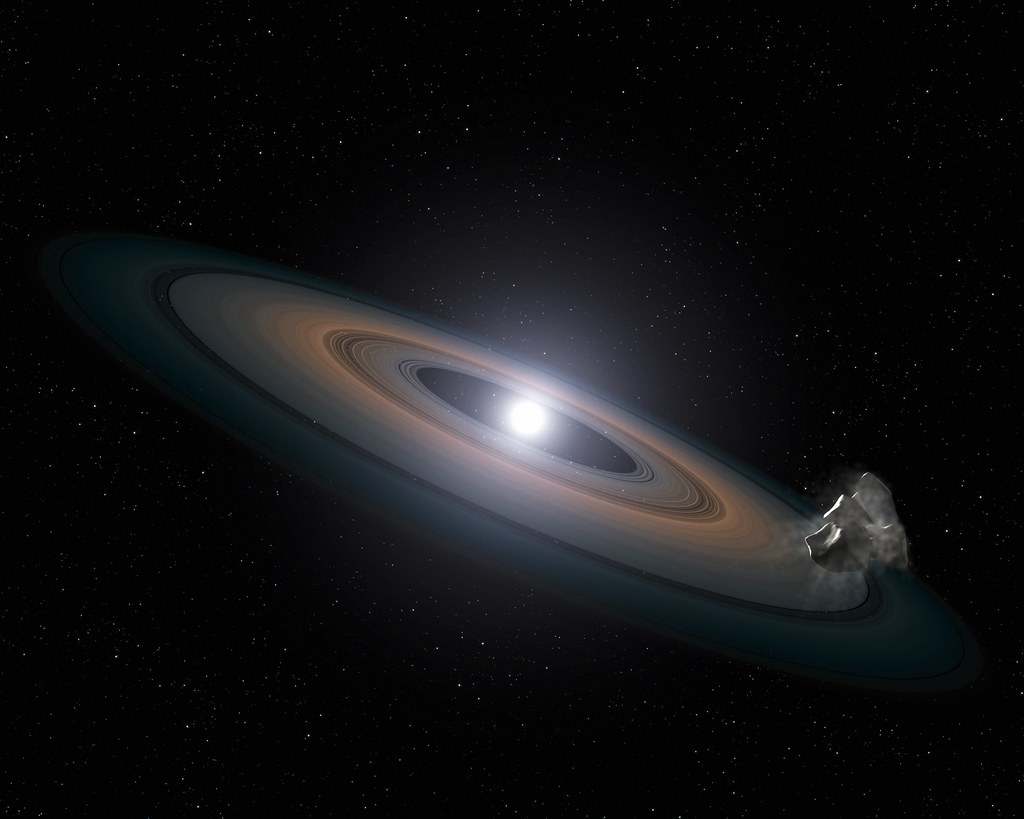A white dwarf star represents the final stage of evolution for stars not massive enough to become neutron stars or black holes. These stellar remains are incredibly dense, packing a mass comparable to that of the sun into a volume similar to Earth. Despite their diminutive size, white dwarfs play a crucial role in our understanding of stellar life cycles.
What is a White Dwarf Star?
| Feature | Description |
|---|---|
| Origin | The leftover core of a low- to medium-mass star after it has exhausted its fuel for nuclear fusion in its main sequence. |
| Composition | Primarily electron-degenerate matter, where electrons are packed so tightly they resist further compression. |
| Size | Roughly the size of Earth, but with a mass comparable to the Sun. This makes them incredibly dense. |
| Temperature | Extremely hot, with surface temperatures exceeding 100,000 Kelvin. |
| Luminosity | Faint, emitting only residual heat. They don’t generate new energy through fusion. |
| Fate | Eventually cool down over billions of years and become black dwarfs (although the universe may not be old enough for any to exist yet). |
| Examples | Sirius B, the companion star to Sirius, is a white dwarf. |
The evolution into a white dwarf begins once a star has exhausted the nuclear fuel at its core. Without the pressure from nuclear fusion to counteract gravity, the outer layers of the star are expelled, leaving the core behind. This remnant cools and dims over billions of years, giving off a faint glow as it gradually loses its residual heat. Observations of white dwarfs, such as those from the system of 40 Eridani, have been important in expanding our knowledge of these compact objects.
Key Takeaways
- White dwarfs are dense, Earth-sized remnants of low to intermediate mass stars.
- Their evolution includes exhaustion of nuclear fuel and shedding of outer layers.
- Observing these stars aids in understanding the life cycle and ultimate fate of stars.
Formation and Evolution
The journey from a billowing red giant to a compact white dwarf is marked by dramatic changes and the cessation of nuclear fusion. This path charts the twilight stages of a star’s life cycle.
From Red Giants to White Dwarfs
When a star has consumed most of its hydrogen, it enters the red giant phase. Its core contracts and heats up, prompting the outer layers to expand. The core is hot enough to start fusing helium into carbon. For sun-like stars, this phase is their second act in life, transforming them as they head towards their end.
End of the Nuclear Fusion Process
As the star burns through its helium, the nuclear fuel reserves dwindle. Without fusion to counter gravity, the core continues to collapse. This collapse raises the core’s temperature, but not enough to sustain fusion of heavier elements like carbon. Once fusion halts, the star has reached a critical stage.
Planetary Nebula and White Dwarf Emergence
In the star’s final stages, the outer layers are ejected, creating a planetary nebula that reveals a white dwarf at its heart. What remains is a dense core, primarily made of carbon and some oxygen. Devoid of nuclear fuel, the white dwarf will slowly cool over billions of years, irrevocably fading away.
Characteristics of White Dwarfs
White dwarf stars are fascinating cosmic objects, displaying extreme masses and densities despite their relatively small size. They are the final evolutionary state for the majority of stars in the universe, including our own sun.
Mass and Density
White dwarfs possess a mass close to that of the Sun, but confined within a volume comparable to Earth. This results in an incredibly high density, with just a teaspoon of white dwarf material weighing approximately as much as an elephant. These stars are made from electron degenerate matter, meaning the electrons are packed together as tightly as quantum mechanics allows.
Temperature and Luminosity
Despite their small size, white dwarfs can be very hot, with temperatures reaching up to 40,000 K near the end of their lives. A white dwarf’s luminosity—the total amount of energy emitted per second—is relatively low, mainly because they are no longer fusing elements at their cores. Instead, they emit energy generated from their residual heat, gradually cooling and fading over time.
Composition and Structure
White dwarfs are typically composed of carbon and oxygen, remnants from the fusion of lighter elements during the star’s former life. As they consist mostly of carbon and oxygen nuclei floating in a sea of electrons, their composition and internal structure differ greatly from that of our Sun. Over billions of years, the coolest white dwarfs may crystallize, effectively turning into giant cosmic diamonds.
Astrophysical Significance
White dwarf stars are not only the remnants of certain stars, they play a crucial role in the grand scheme of astronomy, especially relating to the life cycle of stars, supernovae phenomena, and gauging distances across our galaxy.
White Dwarfs in Binary Systems
White dwarfs often exist in binary systems, twinned with another star in a gravity-bound dance. Astronomers take a keen interest in these systems, as the interaction between the white dwarf and its companion can lead to dramatic astronomical events. For instance, a white dwarf may accrete material from its partner, leading to a nova—a sudden and brilliant burst of energy.
Supernovae and Type Ia Supernova
The most thrilling spectacles involving white dwarfs are Type Ia supernovae. They occur when a white dwarf in a binary system gains enough mass from its companion star to reach a critical threshold and explodes. This explosion is of special importance in cosmology; it helps scientists understand the expansion of the universe. Type Ia supernovae serve as “standard candles” due to their consistent luminosity, which allows for precise measurements of distances throughout the Milky Way galaxy and beyond.
Role in Measuring Galactic Distances
Astronomers employ the light of Type Ia supernovae as a measure to calculate vast distances in space. This method has proven instrumental in refining the values for the rate of expansion of the universe. Tools such as the Hubble Space Telescope have utilized Type Ia supernovae to observe distant galaxies, contributing significantly to the field of cosmology and our understanding of the universe’s history dating back to the Big Bang.
Future Evolution
Once a white dwarf has formed, its future is a slow journey of cooling and fading away. What follows is the gradual transition from a faint white light to an invisible, cold object.
Cooling and Dimming
A white dwarf, bathed in the leftover heat from its previous stages, slowly cools over time. This process takes billions of years, much longer than the age of the universe so far. As it cools, its brightness diminishes, eventually becoming too dim to be seen.
Transition to Black Dwarf
The concept of a black dwarf is theoretical, as none presently exist due to the universe’s current age. It’s predicted that as a white dwarf releases its residual thermal energy, it will cool to a point where it no longer emits significant heat or light. This object would then be a black dwarf, a cold, dark remnant of a once vibrant star. However, reaching this stage would take many times longer than the cosmos has existed. For context, Earth is merely 4.5 billion years old, while this phase of a white dwarf’s life could take quadrillions of years.
Frequently Asked Questions
White dwarfs are fascinating celestial objects and many people have questions about their characteristics and role in the cosmos. Let’s answer some of the most common questions to better understand these dense remnants of stars.
What are the characteristics of white dwarfs?
White dwarfs are dense stars with a mass similar to that of our Sun, but they are only about as big as Earth. This makes them incredibly dense. Their faint luminosity comes from the emission of stored thermal energy rather than active nuclear fusion.
How does a white dwarf star compare to a neutron star?
While both are end states of stars, a neutron star is even denser than a white dwarf and results from the collapse of a more massive star. Neutron stars are composed primarily of neutrons and have even smaller radii and far greater masses than white dwarfs.
What constitutes the composition of a white dwarf star?
The majority of white dwarfs are made up of carbon and oxygen. Their cores are remnants of the nuclear fusion process that once took place in their progenitor stars.
Can we identify the temperature range for white dwarf stars?
Yes, white dwarf stars can be quite hot. Their surface temperatures can range from approximately 8,000 to 40,000 Kelvin, declining slowly over time as they release their stored thermal energy into space.
How can one distinguish a white dwarf star from other stars?
White dwarfs can be distinguished by their small size and low brightness in comparison to other stars. Their high density also results in a significant gravitational pull, despite their small size.
Is a white dwarf considered a final stage in stellar evolution?
Indeed, a white dwarf represents one of the final stages of stellar evolution for medium and low-mass stars. It is the last observable stage before such a star cools and fades from view entirely.







